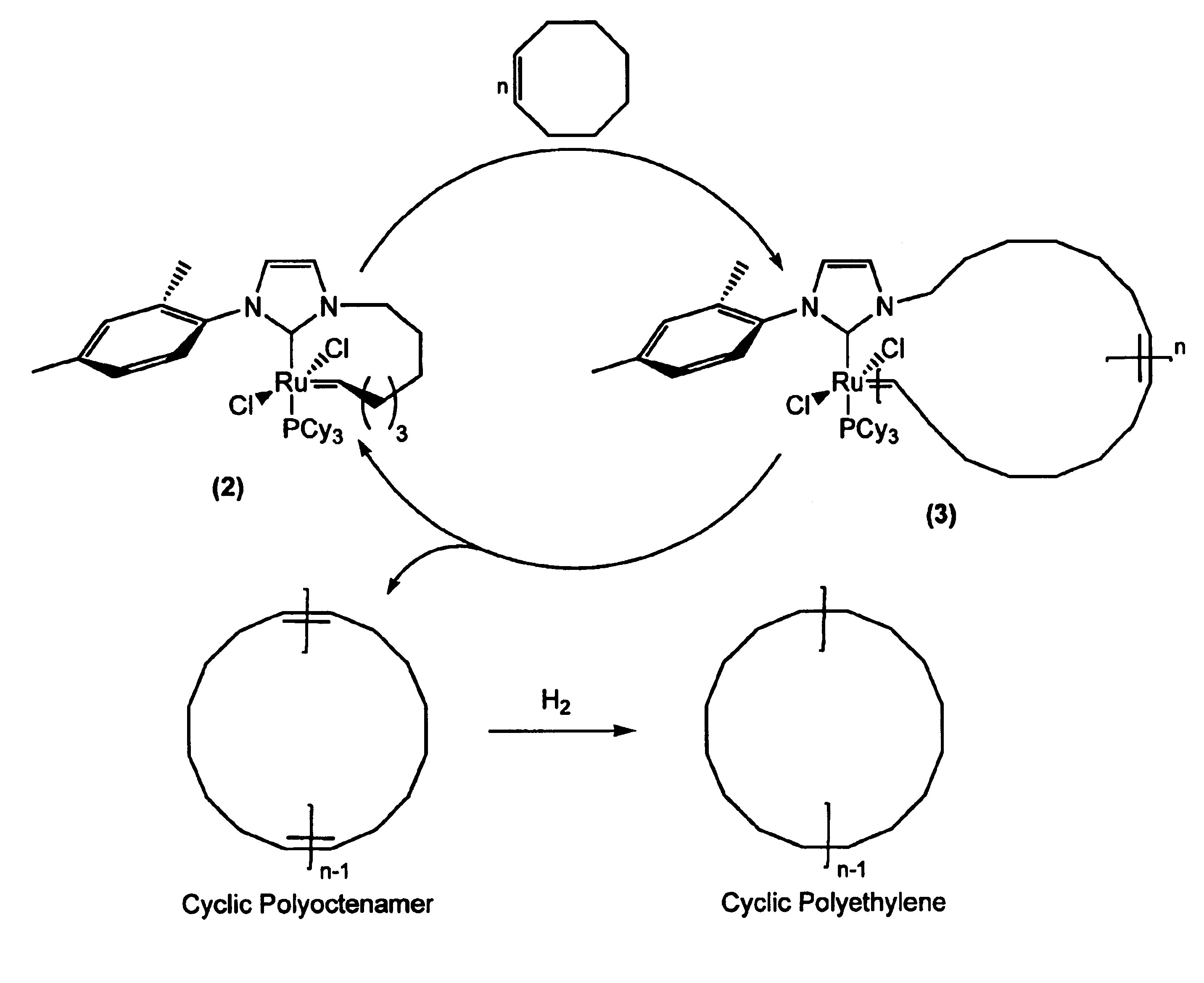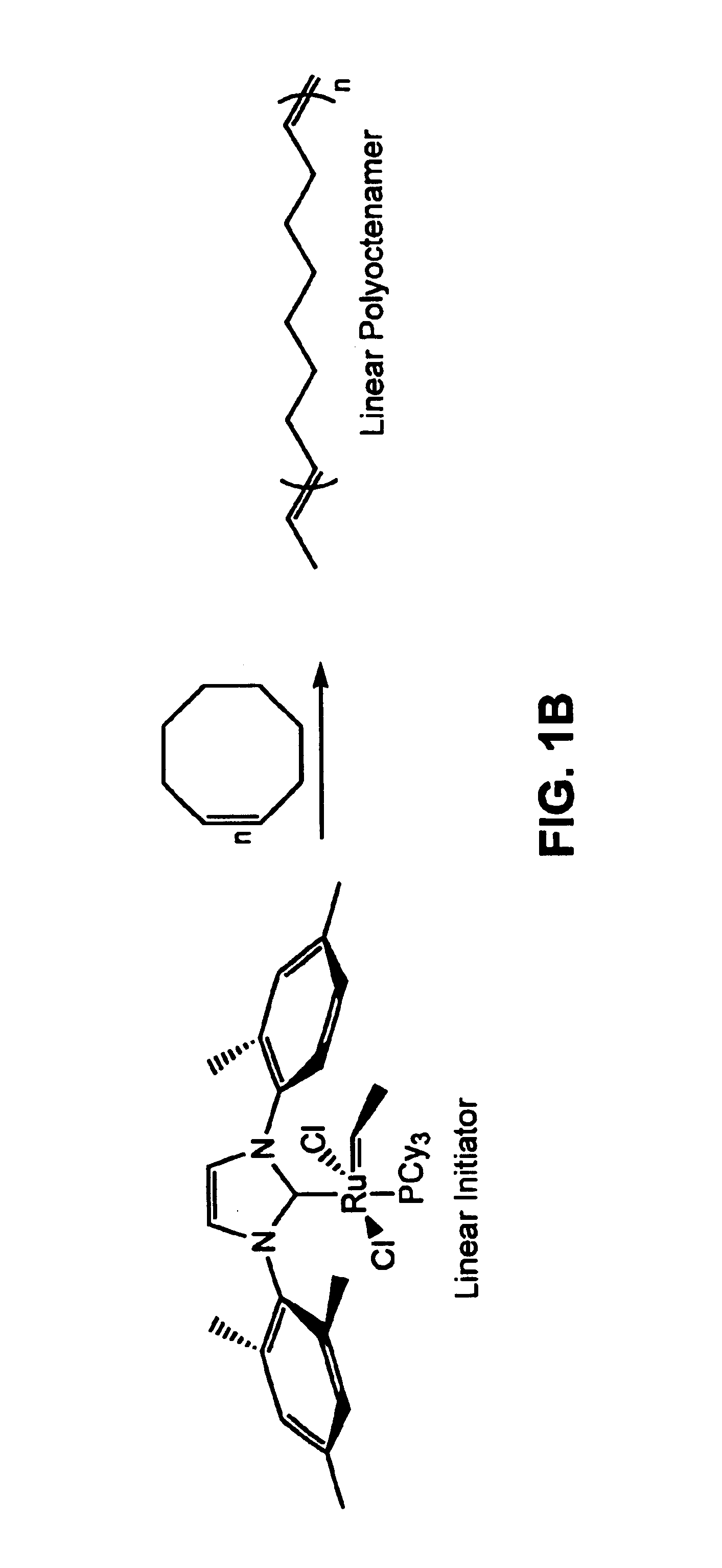Synthesis of macrocyclic polymers by ring insertion polymerization of cyclic olefin monomers
- Summary
- Abstract
- Description
- Claims
- Application Information
AI Technical Summary
Benefits of technology
Problems solved by technology
Method used
Image
Examples
example 1
REPRESENTATIVE CATALYST SYNTHESIS
[0092]A cyclic ruthenium alkylidene complex was prepared using a “one-pot” modification of a previously reported procedure (Fürstner et al. (2002), supra). The synthesis is illustrated in Scheme 5:
[0093]1-Mesityl-3-(7-octene)-imidazole bromide was first prepared by condensing mesityl imidazole with 8-bromooctene in nearly quantitative yield. The resulting salt was deprotonated with (TMS)2NK (TMS=tetramethylsilyl)(1.2 eq) in tetrohydrofuran (THF) at −30° C. for 30 minutes to give (1), followed by in-line cannula transfer to a 0.02 M (toluene) solution of the Ru complex (PCy3)2Cl2Ru═CHPh (Cy=cyclohexyl) at 0° C. This solution was slowly brought to room temperature, and after 1 hour, ligand displacement was determined to be complete by 1H and 31P NMR spectroscopies. The reaction mixture was then diluted with n-pentane to 1 μM and heated to reflux for 2 hours to induce intramolecular cyclization. Purification by column chromatography (hexanes / diethyl e...
example 2
SYNTHESIS OF CYCLIC POLYOCTENAMERS
[0094]Ruthenium alkylidene complex (2), prepared in Example 1, was used to catalyze the synthesis of a cyclic polyoctenamer according to General Procedure A. Addition of (2) to cis-cyclooctene monomer in CH2Cl2 solution at 45° C. initiated polymerization, as schematically illustrated in FIG. 1A. The resulting macrocyclic complex, intermediate (3), underwent intramolecular chain transfer to yield the cyclic polymer and regenerate catalyst (2) in its original form. No additional purification steps were necessary. A variety of polymers with number average molecular weights (Mn) up to 1200 kD were prepared by varying the initial monomer / catalyst ratio and / or the initial monomer concentration. When initial monomer concentrations of less than 0.2 M were used, only low molecular weight cyclic oligomers (MW<2 kD) were obtained. In all cases, the polydispersity indices (PDIs) of the resulting polymers were approximately 2.0.
example 3
COMPARISON OF THE CYCLIC POLYOCTENAMERS WITH CORRESPONDING LINEAR POLYMERS
[0095]The circular structure of the prepared polyoctenamers was confirmed using a variety of characterization techniques. For comparison, a series of linear polyoctenamers with similar molecular weights and PDIs were synthesized using previously reported procedures, schematically illustrated in FIG. 1B). Size-exclusion chromatography (SEC) (FIGS. 2 and 3) indicated that the physically more compact cyclic polymers possessed smaller hydrodynamic volumes (i.e., they eluted later) and had lower intrinsic viscosities than their linear analogs ([η]cyclic / [η]linear=0.4). Viscosity measurements were performed in THF at 30° C. using an SEC-viscometer apparatus. The observed ratio of 0.4 is in accord with theory for cyclic and linear polymers in good solvents (W. Burchard, in Cyclic Polymers (Elsevier Applied Science, London, 1986), pp. 43-84). Furthermore, Mark-Houwink plots (log η versus log Mw) (FIG. 3) ruled out th...
PUM
| Property | Measurement | Unit |
|---|---|---|
| Time | aaaaa | aaaaa |
| Molar density | aaaaa | aaaaa |
| Molar density | aaaaa | aaaaa |
Abstract
Description
Claims
Application Information
 Login to View More
Login to View More - R&D
- Intellectual Property
- Life Sciences
- Materials
- Tech Scout
- Unparalleled Data Quality
- Higher Quality Content
- 60% Fewer Hallucinations
Browse by: Latest US Patents, China's latest patents, Technical Efficacy Thesaurus, Application Domain, Technology Topic, Popular Technical Reports.
© 2025 PatSnap. All rights reserved.Legal|Privacy policy|Modern Slavery Act Transparency Statement|Sitemap|About US| Contact US: help@patsnap.com



